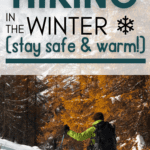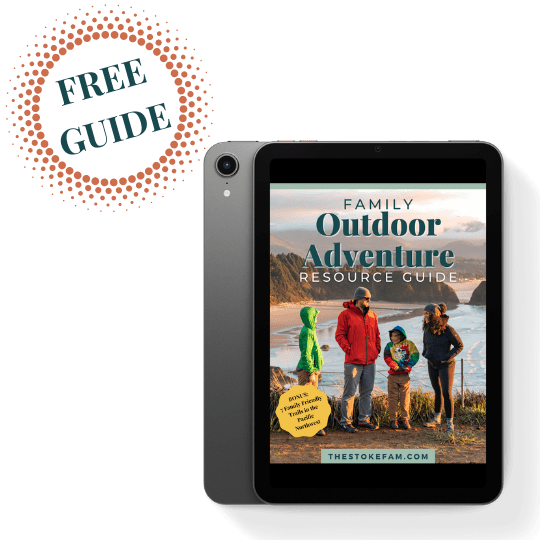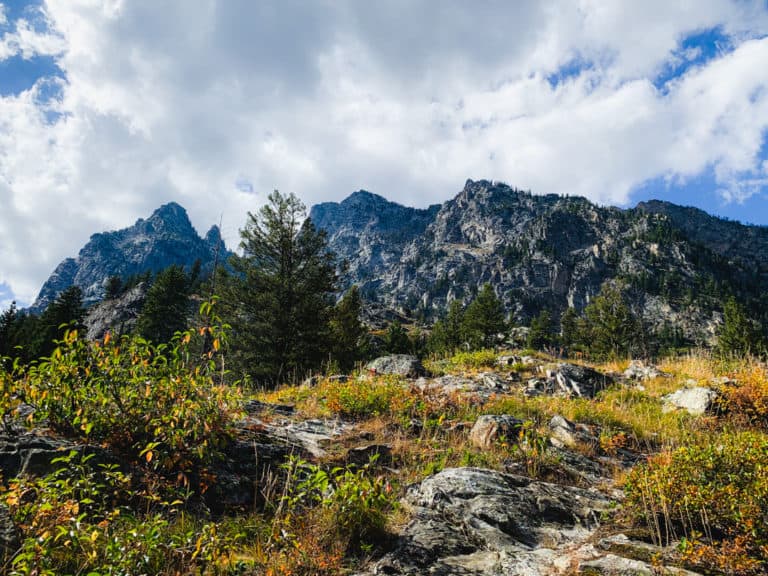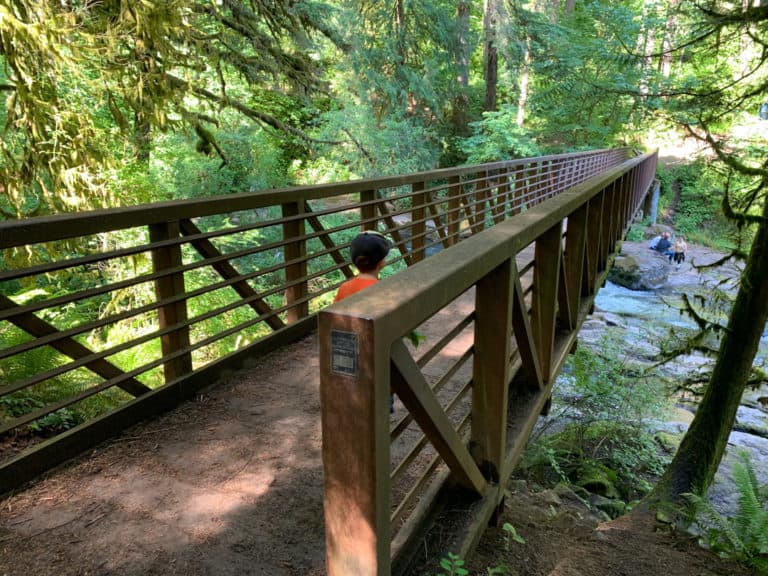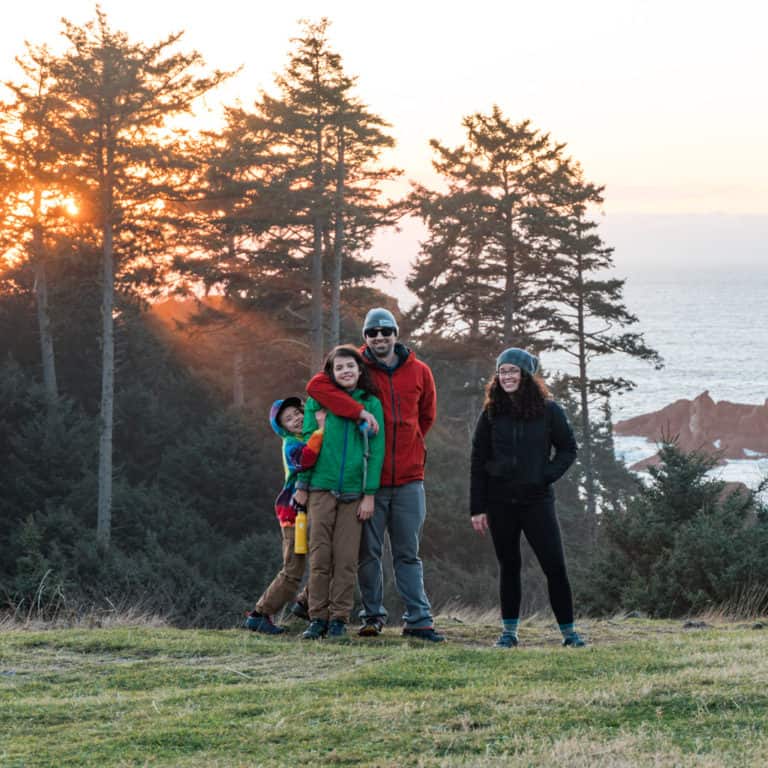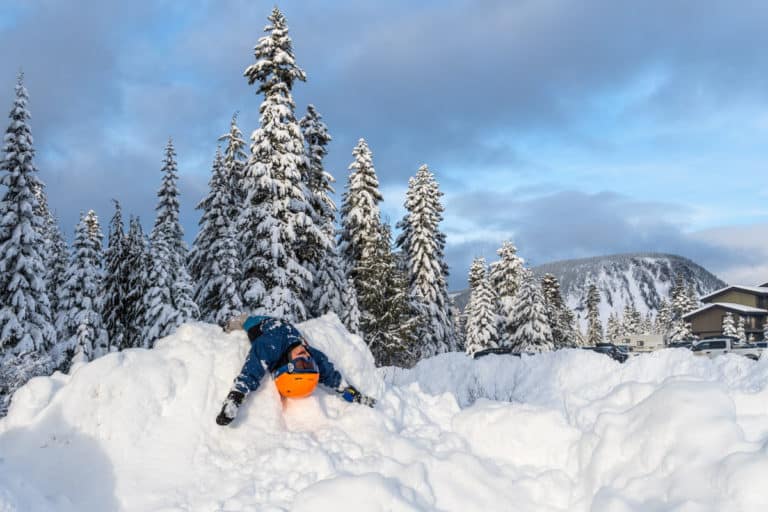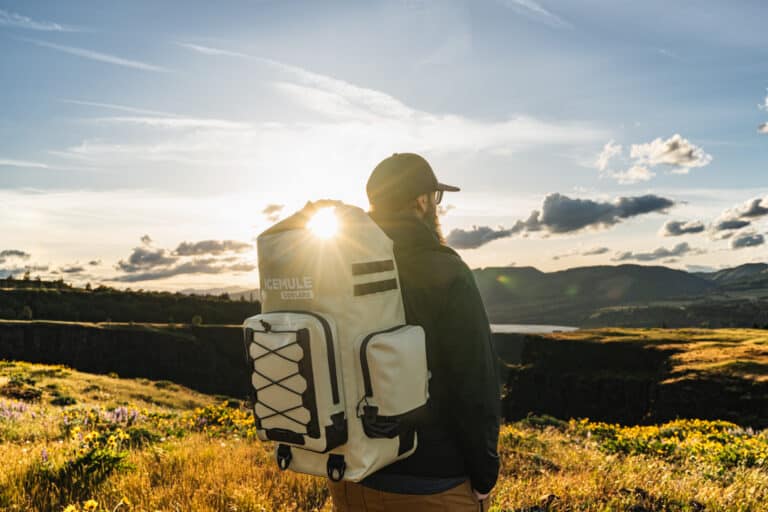I’m not a fan of being cold…at all. In fact, if we’re being honest, I’d be totally fine to live in 80°F weather year-round. 🤷♀️
But over the years, I’ve learned what to wear hiking in winter to make the cold days more enjoyable. Ultimately, it comes down to having the proper gear and creating a solid layering system that will keep you warm even in cold conditions.
Even if it’s not the middle of winter, cold weather can still be a concern during your next hiking trip. In fact, depending on where you live and where you prefer hiking, you can encounter some pretty cold temperatures that can make for a miserable trek if you’re not prepared for them. If you’re looking for some help with your winter hiking gear this year, here are some suggestions for what to wear hiking in winter.
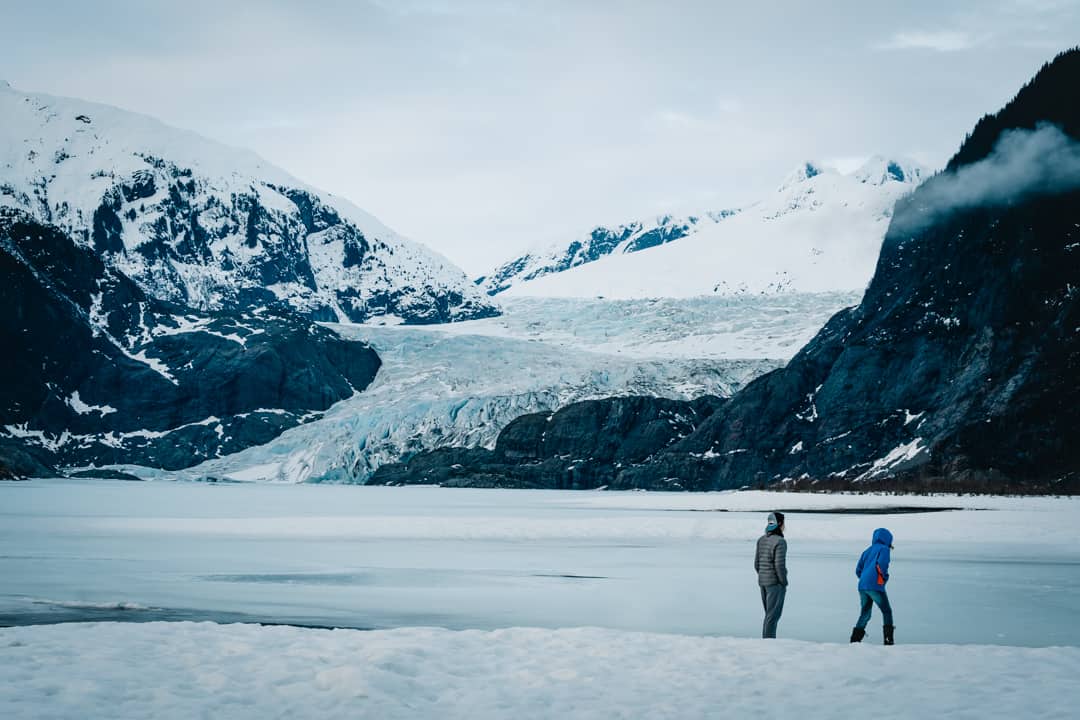
Why You Need Winter Hiking Clothes
Knowing what to wear when you hike can take some time to figure out. Even as a seasoned hiker, I still find myself second guessing sometimes. It’s hard to resist the urge just to put on a wool sweater and think you’ll be fine. Finding yourself freezing mid-hike isn’t just inconvenient; it can be dangerous, and if that bad weather gets worse, you could be in big trouble.
Winter hiking might require you to go out and buy special clothes or some new equipment. However, you can mix and match brands, look for sales, and shop used to find great winter hiking gear without sacrificing quality. Remember that if you buy smart and invest in quality winter hiking gear, many of these will last you a lifetime!
VIP gear stoke
Personal Outdoor Gear Shopper
Overwhelmed by all the choices out there? No idea what to look for in gear? Wish there was an easy button?
I’ve spent years trying different brands and adventure gear so you don’t have to. As your outdoor personal gear shopper, I’ll help you find exactly what you need, quickly and efficiently.
What to Wear Hiking in the Winter – The Best Winter Hiking Gear
Hiking during winter can often mean snowshoeing or hiking through light snow. We tend to use much of the same gear we use when snowboarding, such as snow pants and jackets. However, you’ll notice that our gear aims for warmth, breathability, and waterproofing when choosing items for winter hikes.
While gear lists are helpful, I’ve also provided some insight from an experienced buyer into what to look for and things you might want to take note of before buying these items.
Layering for Hiking in the Winter
The key to staying warm during winter hikes is to wear layers that help you stay dry and warm. You want your layers to protect you from the elements and also keep you from sweating. You may also need to take layers on and off depending on your exertion level and changing weather patterns.
For winter layering, you will need three main layers on your upper body:
- Base layer
- Mid layer
- Outer layer
Base Layer for Hiking in the Winter
The job of your base layer during winter hiking is to regulate your body temperature and wick sweat. When you’re active, you start to sweat, and during the winter, you want to move that perspiration away from your skin to keep you dry and warm instead of damp and cold. Aim for synthetic fabrics or merino wool for your base layers.
We recommend:
- Title Nine Crash 2.0 Polartech Leggings: These are a great base layer or standalone pants for cold weather hikes.
- Patagonia Capilene Layers
- evo Ridgetop Layers
- Smartwool Merino Baselayers
Mid Layer for Hiking in the Winter
This middle layer has several vital functions while you are hiking. The middle layer works as an insulating layer while you’re hiking. This will helps you maintain body heat by trapping warm air close to your body and providing you with built-in insulation. This insulating layer should be made of down, synthetic, or fleece materials. If you want a quality mid-layer jacket, try a puffy or fleece jacket from Patagonia, Title Nine, Cotopaxi, Columbia, or Mountain Hardwear.
We recommend:
- Ghost Whisperer Puffy Jacket (Down) from Mountain Hardwear
- Title Nine Annapurna Snap Fleece Pullover
- Cotopaxi Fuego
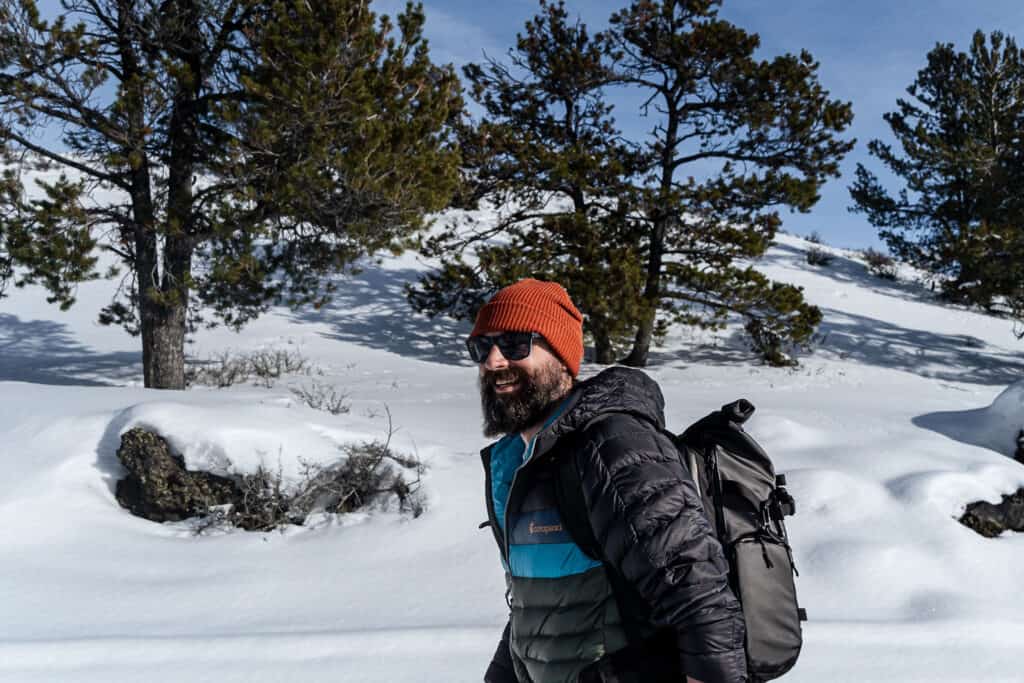
Outer Layer for Hiking in the Winter
A waterproof outer shell is essential during winter hikes. During the winter months, you could run into sleet, snow, rain, or wind on your hikes through the Pacific Northwest. You want to have a breathable and waterproof outer layer but packable so you can put it in your daypack when you’re not wearing it. For us, this usually comes in the form of a rain jacket on top of layers (base and mid) or a heavier winter jacket.
We recommend:
Snow jacket
How to Choose a Winter Coat
When looking for winter coats and jackets, there are a few things you’ll want to look for to stay warm and dry in any weather.
Waterproof Pants for Hiking
If it is windy or extra cold, you may want to add a second layer of pants. When it’s actively raining or snowing, we often opt for water-resistant or waterproof pants, such as rain or snow pants over a base layer. For more mild winter hikes that aren’t in the snow, we will pass on the snow pants and stick to layering just as we do when we hike in the fall.
We recommend:
- Women’s [ak] Kimmy GORE-TEX 2L Bib Pants
- Title Nine Snow Slayer: These are made of soft shell material and run a bit small, in my opinion. If you get these, make sure you get a size up if you want to wear a base layer underneath.
- PrAna Halle Pants for women or Prana Zion for men: While not waterproof, these pants do have some water resistance. They have some stretch, but if you regularly wear a baselayer underneath, I suggest sizing up one size.
The Stretch Zion Pants from prAna are perfect for outdoor adventures. They are comfortable, made with PFAS-free DWA fabric, and move with you. They wash and dry easily and hold up great.
Winter Hiking Footwear
It’s so important to wear shoes appropriate for winter to keep your toes warm and your feet dry as you’re walking through the trails on cold-weather hikes.
Socks
During winter hikes, I recommend wearing heavier socks such as merino wool. You can also opt for thicker socks made of synthetic materials to keep your feet warm and dry. Sock liners are also another option if you are prone to blisters or want the additional layer. Just make sure you have plenty of space in your boots to wiggle your toes to allow blood circulation and foot warmth. It’s also a good idea to bring an extra pair of socks with you during this time of year. That way, if your feet do get wet, you have another pair of warm socks ready to go.
I love that Darn Tough socks come in a wide variety of styles and weights for adventuring in different conditions. These lightweight crew socks are my go-to choice with my Oboz hiking boots for most hikes in fall, winter, and spring.
Hiking Boots for Winter
The last thing you want is cold feet on a long hike. Insulated winter boots are compatible with microspikes, snowshoes, and other accessories and can keep you warm in extreme temperatures. When we are snowshoeing or hiking in the snow, I prefer a high boot to keep my feet dry and protected. You can also opt for gaiters to keep the snow out of your hiking shoes or boots.
We recommend:
- Oboz Bridger 7″ Insulated Waterproof Boots – Women’s
- Neo-Classic Solid Kids’ Winter Boots: These are great for kids during shorter hikes.
- KEEN Kootenay III Waterproof Snow Boots These insulated boots are perfect for longer hikes in extreme temperatures.
- KEEN Targhee III Waterproof Mid-Hiking Boots – Men’s
- Altra Hiking Boots: I recommend either the Altra Olympus Mid Waterproof or Lone Peak Mid Waterproof hiking boots for adults.
Hiking with kids
Find Hiking Shoes for Kids
Don’t forget about a quality pair of hiking shoes for your kids. Keeping little feet warm and dry is even more important during winter!
Other Winter Hiking Essentials
A warm hat, gloves, and additional winter hiking accessories are equally as important as the rest of your hiking clothes. As you warm up and adjust to the colder temperatures, you’ll be glad you had these essentials for cold-weather layering and for wearing on extreme-weather hikes. They’re easy to take on and off and take up minimal space in a hiking pack.
Scarves and Neck Gaitors
When hiking, any exposed skin can cause frostbite or keep you cold. Neck gaiters or scarves are essential for winter weather hiking! I tend to prefer neck gaiters (also called neck tubes or buffs), but which one you choose will come down to personal preference. Keep your neck and face warm with these, and make sure to tuck scarves in so they don’t get loose or fall out while you’re hiking.
A neck warmer or neck tube is an essential part of our snowboarding gear. It helps to cut the wind on your neck, but can also be pulled up over your face to shield it from the cold and snow. Fleece options are durable and inexpensive, while maintaining warmth.
Microspikes and Snowshoes
If you are hiking in deep snow, you will need snowshoes. However, if the snow you are hiking through isn’t very deep or you’re hiking through icy trails, you need something to add to your shoes to keep your feet from slipping. This is where microspikes come in (or crampons on more technical, steep terrain). Microspikes are great to help get traction while hiking on ice or snow.
We recommend:
Gloves and Mittens
When hiking in cold weather conditions, gloves or mittens are non-negotiable. Protecting your extremities can help keep you from frostbite and protect your hands from blisters if you’re using hiking poles. Even if you think you won’t need them, you should always have a pair in your hiking backpack.
Trekking Poles
Trekking poles will help you with balance while hiking in the slippery snow. Many trekking poles have basket attachments to add to a regular pair of trekking poles for winter hiking.
We recommend:
Hats
You will lose heat through the top of your head, so finish off your outfit with a nice warm hat and keep your forehead and ears warm while also keeping your head warm too! I have several beanies I love, but one of my favorites is a wool beanie from Grace Eleyae that is satin lined to protect my curls – especially if we’re going anywhere after our hike where I expect to take it off.
Other brands with beanies we love:
Sunscreen
It might not be hot like during summer, but don’t overlook the need for sunscreen. Higher elevations mean that UV rays will be more intense, and snow reflects the sun, so you can still get sunburned even in the winter.
Sunglasses
Bring sunglasses for eye protection if you’re hiking on a sunny day. Snow can reflect the glare of the sun and damage your eyes. Even if the skies look cloudy, it’s a good idea to bring a pair just in case.
Tips for Staying Warm While Hiking in the Winter
Your equipment is ready, and it’s time to get ready for your first winter hike. I don’t need to tell you that it’s going to be cold outside, so here are some tips to help you stay warm while hiking in the winter.
- Bring a thermos (we love these) with a hot drink inside: Take a few sips when you stop to rest. Hot tea or chocolate can help warm you up on the trail.
- Don’t stop in the shade: When you can, hike out in the sun. It will be significantly warmer there.
- Don’t sit right on the snow when you take a break: You might think you have a ton of layers to keep you warm, but the last thing you want is a wet butt and to be sitting on something cold.
- Consider taking a lightweight foam pad: A closed-cell foam seat pad like this one from NEMO will give you a dry, comfortable place to sit for breaks.
FAQ
How do you stay warm during winter hiking?
Most importantly, to stay warm during winter hiking, you’ll want a great layering system that includes an insulated midlayer and a waterproof outer layer to keep you dry in wet weather. While having the best winter hiking gear is needed, there are a few other tips to keep in mind to stay warm while you’re hiking.
Make sure you stay hydrated and have a snack on hand during your hikes in the cold. The body will burn calories quickly while you’re hiking. You’ll burn calories even faster if you’re shivering and cold during the hike. Having a full belly and staying hydrated is important to keep your body running as smoothly as possible to keep you warm.
Packing extra socks is also essential (we recommend wool socks like these from Darn Tough because the last thing you want to have to happen is to end up with wet feet. If you happen to get your socks wet, remove them and put them on dry socks as soon as possible.
Lastly, keep moving! You can keep your body warmer by just walking around and moving. The moment you stop, you’ll notice and feel the cold that much more.
What temperature is too cold for hiking?
This can actually vary depending on how well of a hiker you are and how acclimated you are to the weather. For most, anything less than 40 degrees Fahrenheit will be too cold to hike without proper winter hiking gear and extra precautions.
We regularly hike or snowshoe at temps lower than 40°F. Still, there are additional things we take into consideration at these temperatures. It’s essential to have an understanding of survival skills, how to maintain warmth, and how to avoid frostbite.
This is where having the best hiking gear on your body at all times becomes super important.
Is it bad to hike in winter?
It’s not bad at all as long as you’re prepared! Remember that in order to have an enjoyable hike in cold weather, you need to make sure that you’re packed, layered, and ready for varying conditions.
A surefire way to make a hike bad in the winter is to attempt to do that hike unprepared and without the proper winter hiking gear.
Do you need Spikes to hike in winter?
Microspikes can be helpful to have on hand when you’re hiking in winter, but they aren’t always a requirement. It’s essential to pay attention to the terrain, snow levels, and weather forecast to know what you need to plan for on your hike.
Some trails can be very slippery and dangerous in winter if you’re hiking in snow and ice. In these instances, spikes will be a helpful asset on your feet for additional traction and safety. There have been instances where we’ve literally watched people slip and slide on icy trails – these are the scenarios where, yes, you absolutely should have microspikes.
That said, if there isn’t snow or ice on the ground, there isn’t a reason to wear them at that moment in time.
Can I wear jeans on a winter hike?
It’s not recommended to wear jeans on a winter hike for several reasons. Most importantly, if denim gets wet, it will get stiff in the cold or might even freeze fully. Not only would this make for a very uncomfortable hike, but more importantly, it could be dangerous and even put you in a life-and-death situation. Staying warm and dry in winter is essential to survival. Becuase of this, denim is not recommended for winter hikes.
In addition, denim doesn’t move with you as more technical clothing will. Plan on wearing appropriate hiking pants so you can move freely and hike, step, and react as needed during the hike.
I make gear shopping easy.
Click below to learn more about my personal shopping service for outdoor gear!
Final Thoughts on What to Wear Hiking in Winter
Choosing the right hiking clothes for winter is vital for comfort and safety while you’re on the trail. Layering for the cold is a balancing act, and it’s easy to overdress if you don’t know any better. Hopefully, this post has helped you prepare for winter hiking and given you the essentials you need for layering in the cold and staying safe and comfortable while on the trail during the winter.

